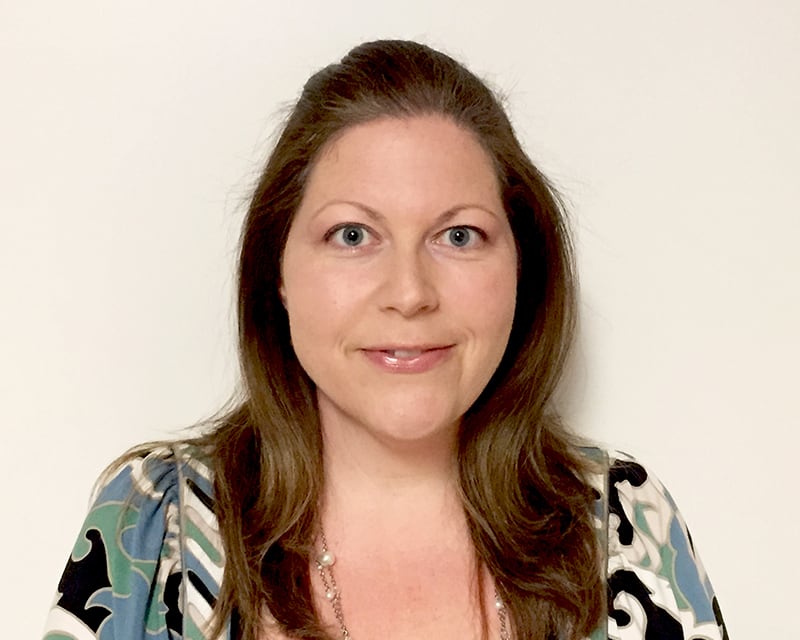Sarah J. LaRosa is a 2013 graduate of the UAB Graduate Certificate in Low Vision Rehabilitation program. An employee of Brooks Rehabilitation in Jacksonville, Florida since 2009, she developed the outpatient vision rehabilitation occupational therapy program at the Brooks Rehabilitation Center for Low Vision in 2013.
She is passionate about her work, her patients, her research and her education in the field of vision rehabilitation. Recently, LaRosa chatted with us about her innovations, initiatives and the importance of being a continual learner as an occupational therapist and low vision practitioner.
Q: How did the UAB LVRC help you personally?
A: “The certificate has equipped me with the education and skill set I need to provide practical life solutions to very complex every day problems directly related to vision impairment, such as being able to manage medications or prepare meals safely. The program has given me the knowledge needed to collaborate with eye care physicians to teach people how to use the remaining vision they have so they can safely continue engaging in their daily meaningful activities. I learned how to use assistive technology, optics, adaptive equipment, and visual skills training, alongside my existing skill set as an occupational therapist, to improve functional outcomes for my patients.”
Q: How did the UAB LVRC help you professionally?
A: “Being awarded the certificate has validated me as a professional and leader in the niche area of low vision rehabilitation in my region of healthcare. This has made it possible to develop and spearhead the vision rehab program at Brooks Rehabilitation with the support of our executive staff and alongside Dr. Katelyn Jordan, our low vision optometrist, that now operates across our continuum of care serving people in the acute care, inpatient hospital, outpatient, skilled nursing and home care divisions. I work alongside ophthalmologists, optometrists, physiatrists, physical therapists, peer occupational therapists, speech language pathologists, nurses, driving rehab specialists, fall prevention specialists and neuro psychologists to help improve safety and function for the people we encounter with loss of eyesight.”
Q: How have you been able to advance low vision rehabilitation within your facility?
A: “Opening our outpatient vision rehab clinic has been a huge accomplishment and asset to our system of care and low vision community. Furthermore, I think just the fact that we have advocated so heavily to have vision rehabilitation services attainable throughout our entire Brooks’ system of care is a great accomplishment.
As a result of our efforts, we have been able to grow our program tremendously to encompass the entire patient continuum of care from acute care to our home division and help shape plans of care for our entire interdisciplinary team. This initiative has involved the entire rehabilitation community and encouraged all staff and caregivers to get on board and address visual barriers to functional activities. For example, our physical therapists work closely now with our optometrist and low vision OT when rehabbing their clients with vision impairment to ensure best outcomes. Our speech therapists likewise are using a similar team approach to patient care.”
Q: What innovative ideas are becoming a reality?
A: “1) We are presently in the process of submitting grant applications to fund public transportation for therapy services. 2) With our Research and Development team, we are conducting a randomized clinical trial for the use of vital stim (neuromuscular electrical stimulation) to treat ptosis and lag ophthalmus for our clients with neurologic changes. 3) We are also working with our marketing and administrative staff to develop an education web based portal accessible to all Brooks’ staff to impart knowledge on how to screen and identify vision loss in our Brooks’ clients. This will be a great resource to staff in general. Dr. Katelyn Jordan, OD, and myself also present locally at ‘Stepping On’ fall prevention group sessions to link vision loss to falls and provide helpful strategies to preventing falls with regard to vision loss. These presentations help us to promote health and wellness for our aging folks in the community.”
Q: What changes in the Low Vision field have you initiated?
A: “I have established mandatory competency training curriculum for our occupational therapists and assistant staff. I have provided staff and peers with training and developed CEU courses through our Brooks Institute of Higher Learning to promote increased understanding of vision and visual barriers to safe function and rehab.”
Q: What takeaways from the UAB LVRC program helped the change?
A: “My professors at UAB really helped me to understand the impact of vision rehabilitation specialists on the community as a whole, and the need for this level of expertise in community. There just aren’t many resources for people with vision loss. We, as OTs, like to promote a person’s ability to “age in place, in their own home” and advocate for persons of all ages to continue to be able to participate in all activities of need or choice regardless of visual barriers.”
Q: What does the future hold for the Low Vision field?
A: “I have been heavily advocating for physical therapy to be more involved in low vision rehabilitation, and would love to see us sponsor courses to train physical therapists to become orientation and mobility specialists. Adding the expertise of physical therapists to vision rehabilitation would be quite powerful, as they would be able to use their knowledge and expertise of the musculoskeletal system, gait training and use of durable medical equipment to provide effective low vision strategies for safe home and community mobility.”
